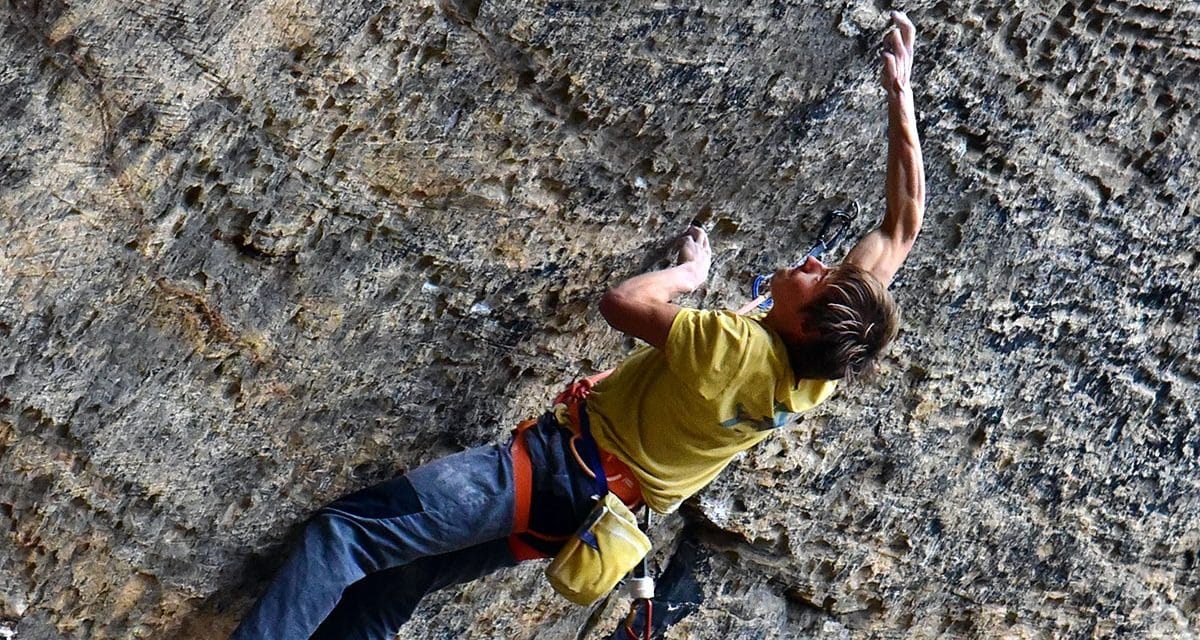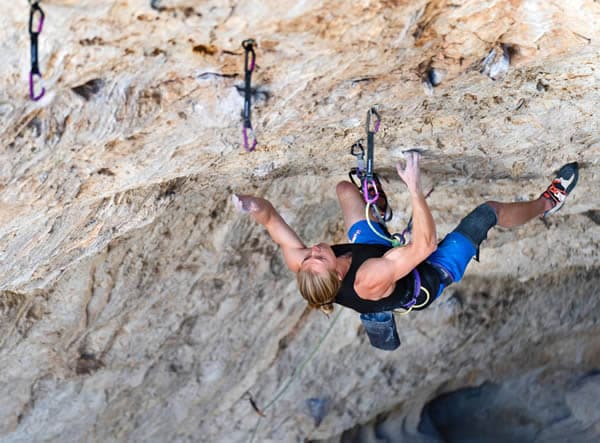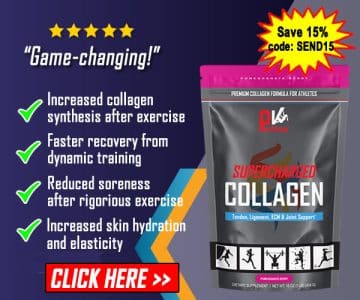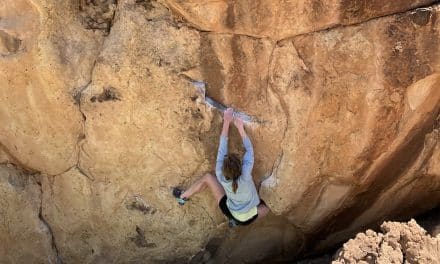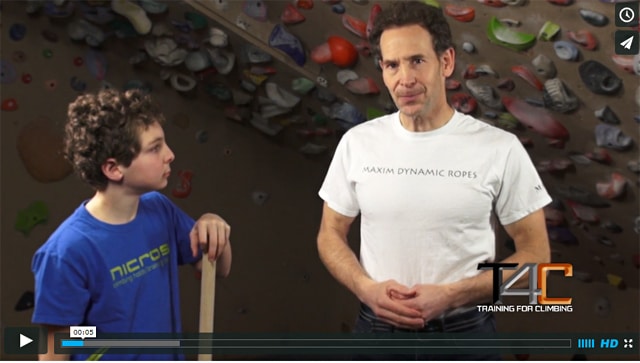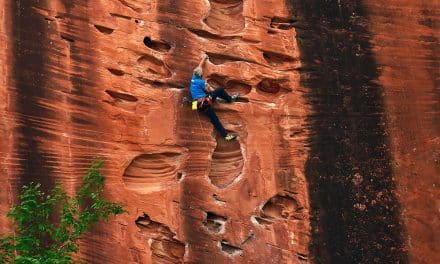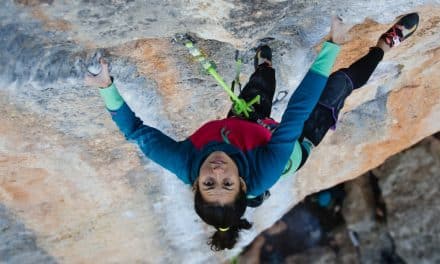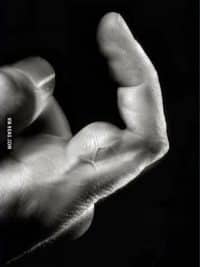
Your fingers aren’t strong enough until they look like mini biceps! LOL
While climbing remains a skill sport first and foremost, strength in tandem with skill is still an essential piece of the equation. Long-term improvement demands climbing-specific strength, especially when it comes to stronger fingers!
(This article was originally published in June of 2016, but strong fingers haven’t lost their value one bit.)
Numerous research studies have confirmed that elite climbers have higher finger strength-to-mass ratios, greater forearm endurance, and higher rates of force development in the finger flexors when compared to more recreational climbers. This means that, assuming that you already possess solid technical and mental skills, taking your climbing to the next level depends on developing stronger fingers. Here are five reasons why.
1. Stronger fingers can grip smaller holds.
Duh! Seriously, though: gripping smaller and smaller holds—crucial for climbing harder—depends on building a higher level of limit grip strength. Hangboard training (using proper training protocol) is unquestionably the best method for training maximum grip strength. The campus board rules then trains contact strength (i.e higher rate of force development in the finger flexors).
2. Stronger fingers can hang longer on submaximal holds.
This one requires a bit of exercise physiology, so bear with me for a moment. When your fingers are gripping at just 20% of maximum voluntary contraction (MVC), blood flow through your forearm flexor muscles begins to slow. At a contractile force of about 50% of MVC or higher, blood flow stops completely. When blood flow slows or stops, power output declines precipitously after about 10 seconds. Depending on the relative difficulty of the sustained grip (or % of MVC), failure will follow in a matter of seconds to, at best, a minute or two if the finger flexors are contracting at a force far lower than 50% MVC.
Lack of blood flow and oxygen supply is the crux of the matter, since oxygen is required for creatine phosphate resynthesis and CP is a vital intracellular energy source. Blood flow is necessary for removing metabolic byproducts of anaerobic lactic energy production. Thus, when resistance climbing through a long sequence of relatively difficult yet submaximal holds, the greater the perfusion (or delivery of blood to the capillary bed) the longer you can endure.
Given blood flow occlusion as a function of the percentage of maximum voluntary contraction (MVC), it makes sense that gaining a higher level of maximum grip strength (or a greater MVC) allows for supporting your body weight with a smaller percentage of MVC. This becomes a critical guiding principle for effective training!
TL;DR: Increasing the MVC of the finger flexor muscles enables contraction at a lower percentage of your max when climbing on similar submaximal terrain, which allows for increased blood flow, greater use of the aerobic energy system, and improved forearm endurance.
3. Stronger fingers can rest and recover on smaller holds.
I’m sure you’ve seen videos of rock stars like Jakob Schubert, Stefano Ghisolfi, and Adam Ondra pausing in the middle of some long, steep, and ridiculously hard climb to shake out and somehow rest on a small “finger bucket” that most of us would shiver at the sight of. Yet somehow these guys can stop, catch their breath, and recover enough power to push on and finish the climb. What’s their secret to resting on such small holds that would pump out the average climber?
Strong fingers, of course!
As explained in the second point, blood flow is the key to resynthesizing CP (essential for brief, high power movements) and removing fatiguing metabolic byproducts of the anaerobic lactic energy system (the predominant energy system when climbing hard, sustained sequences lasting between twelve seconds and a minute or so). For a rest hold to be good enough for meaningful rest (let’s say 15-30+ seconds), you must be able to grip the hold using less than 50% of your MVC. This is the only way to rejuvenate enough blood flow within both the shaking and gripping arms. Therefore, a climber with “average” grip strength may require a four-inch deep hold to recover since this is the smallest hold he can grip for an extended time at less than 50% MVC. Meanwhile, the 5.15 climber can likely shake out on a one-inch deep hold thanks to a very high relative grip strength.
4. Stronger fingers have more stamina.
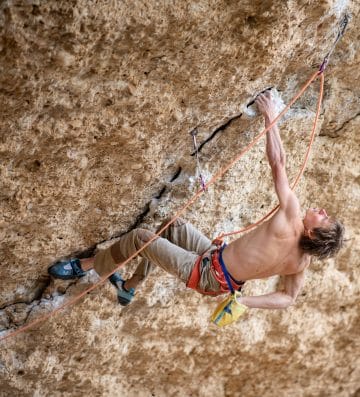
Alex Megos maxin’ and relaxin’ on small holds thanks to his finger strength.
Alex Megos resting on holds that would make most of us scream…thanks to his finger strength!Occasionally you hear a mind-boggling media report of some pro climber on-sighting or redpointing multiple 5.14 routes in a day, and again the next day…and maybe even again the next!
How is this even possible?
Let me tell you a story about a climber you may have heard about named Alex Megos who does this with regularity. While climbing with Alex at the New River Gorge, he warmed up on a couple 5.13+ routes and then proceeded to do the first ascent of a 5.14b and a second-go second ascent of another 5.14b all within a matter of hours. Sounds like a pretty darn tiring day of climbing, right?
Not for Alex. In fact, he’d climbed other routes at the 5.14 grade both the day before and more the day after! What?!
I must point out here that Alex also possesses world-class technique and am incredibly strong mind. That said, however, the main point here is that Alex is really strong! We have yet to see what Alex’s true climbing limit is (which will be fun to watch over the coming years), but I can tell you for certain that climbing 5.14b routes is nowhere near his limit. So for Alex to climb at this level on successive days is similar to 5.12 climber doing 5.11 routes on successive days or a 5.14 climber sending multiple 5.13a routes.
The bottom line: By increasing your limit strength and advancing your top-end climbing ability, you can elevate the submaximal level at which you can climb with relative ease. A long-term training commitment to getting stronger (as well as improving your mental and technical game) means your project today may eventually become your warmup!
5. Strong fingers make climbing more fun.
Pulling on smaller holds and gliding more easily over difficult terrain brings joy to the heart. Not to mention the fact that breaking into the next grade and sending a hardest-ever route is a rare, transcending experience that can make your season—and your life!
“Pro Tips” for Stronger Fingers:
Tip #1. A haphazard, shotgun approach to finger training (i.e. doing lots of everything) will be, at best, marginally effective…and might even get you injured. Steady, long-term gains in grip strength come from following an intelligent, appropriate program for your ability level and climbing experience that dovetails just the right training stimulus with adequate rest. Find this in the book Training for Climbing and this free Hangboard Training Guide.
Tip #2. Finger injuries are frighteningly common, and each injury represents a massive setback in your training and pursuit of greater finger strength. Adequate rest and enough protein is essential for supporting connective tissue and muscle remodeling/strengthening. PhysiVāntage Supercharged Collagen does the trick for many of the world’s top boulderers and sport climbers to promote finger tendon and pulley health. Learn more about the science behind collagen for climbers.
Related Articles:
- How to Develop Stronger Fingers and Tendons for Climbing
- The Secret to Stronger Fingers When It Counts
- Five Reasons Why Stronger Fingers Matter
- Five Training Tips to Climb Effectively
- Three Hangboard Tests to Gauge Your Climbing Ability
Copyright © 2000–2025 Eric J. Hörst | All Rights Reserved | Hörst Training, LLC

